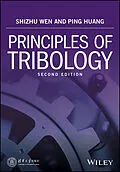Updated to include the timely and important topics of MEMS and rolling friction, Principles of Tribology is a compilation of current developments from tribology research, coupled with tribology fundamentals and applications. Essential topics include lubrication theory, lubrication design, friction mechanism, wear mechanism, friction control, and their applications. Besides classical tribology content, the book also covers intersecting research areas of tribology, as well as the regularities and characteristics of the tribological phenomena in practice. Furthermore, it presents the basic theory, numerical analysis methods and experimental measuring techniques of tribology as well as their application in engineering.
- Newly expanded and updated to include new tribological material on MEMS and green tribology, its key concepts and applications
- Systematically brings the reader through fundamental theories, basic mechanisms through to the latest research
- Emphasizes practical tribological phenomena, supported by numerical analysis and experimental measurement techniques
- Discusses nano-tribology, thin film lubrication and its applications, topics which are growing in importance
A comprehensive look at the fundamentals and latest research, this second edition of Principles of Tribology is an essential textbook for graduate and senior undergraduate students specializing in tribology and related mechanical engineering fields.
Autorentext
SHIZHU WEN, Tsinghua University, China
PING HUANG, South China University of Technology, China
Inhalt
About the Authors xxi
Second Edition Preface xxiii
Preface xxv
Introduction xxvii
Part I Lubrication Theory 1
1 Properties of Lubricants 3
1.1 Lubrication States 3
1.2 Density of Lubricant 5
1.3 Viscosity of Lubricant 7
1.4 Non-Newtonian Behaviors 12
1.5 Wettability of Lubricants 16
1.6 Measurement and Conversion of Viscosity 19
References 21
2 Basic Theories of Hydrodynamic Lubrication 22
2.1 Reynolds Equation 22
2.2 Hydrodynamic Lubrication 26
2.3 Elastic Contact Problems 29
2.4 Entrance Analysis of EHL 34
2.5 Grease Lubrication 38
References 40
3 Numerical Methods of Lubrication Calculation 41
3.1 Numerical Methods of Lubrication 42
3.2 Numerical Solution of the Energy Equation 54
3.3 Numerical Solution of Elastohydrodynamic Lubrication 60
3.4 Multi-Grid Method for Solving EHL Problems 68
References 76
4 Lubrication Design of Typical Mechanical Elements 78
4.1 Slider and Thrust Bearings 78
4.2 Journal Bearings 81
4.3 Hydrostatic Bearings 88
4.4 Squeeze Bearings 92
4.5 Dynamic Bearings 96
4.6 Gas Lubrication Bearings 102
4.7 Rolling Contact Bearings 106
4.8 Gear Lubrication 108
4.9 Cam Lubrication 114
References 116
5 Special Fluid Medium Lubrication 118
5.1 Magnetic Hydrodynamic Lubrication 118
5.2 Micro-Polar Hydrodynamic Lubrication 124
5.3 Liquid Crystal Lubrication 130
5.4 Electric Double Layer Effect in Water Lubrication 137
References 145
6 Lubrication Transformation and Nanoscale Thin Film Lubrication 147
6.1 Transformations of Lubrication States 147
6.2 Thin Film Lubrication 152
6.3 Analysis of Thin Film Lubrication 158
6.4 Nano-Gas Film Lubrication 161
References 169
7 Boundary Lubrication and Additives 171
7.1 Types of Boundary Lubrication 171
7.2 Theory of Boundary Lubrication 179
7.3 Lubricant Additives 185
References 189
8 Lubrication Failure and Mixed Lubrication 190
8.1 Roughness and Viscoelastic Material Effects on Lubrication 190
8.2 Influence of Limit Shear Stress on Lubrication Failure 195
8.3 Influence of Temperature on Lubrication Failure 200
8.4 Mixed Lubrication 203
References 207
Part II Friction and Wear 209
9 Surface Topography and Contact 211
9.1 Parameters of Surface Topography 211
9.2 Statistical Parameters of Surface Topography 213
9.3 Structures and Properties of Surface 217
9.4 Rough Surface Contact 219
References 223
10 Sliding Friction and its Applications 225
10.1 Basic Characteristics of Friction 225
10.2 Macro-Friction Theory 228
10.3 Micro-Friction Theory 238
10.4 Sliding Friction 243
10.5 Other Friction Problems and Friction Control 246
References 250
11 Rolling Friction and its Applications 252
11.1 Basic Theories of Rolling Friction 252
11.2 Applications of Rolling Tribology in Design of Lunar Rover 271
References 280
12 Characteristics and Mechanisms of Wear 282
12.1 Classification of Wear 282
12.2 Abrasive Wear 285
12.3 Adhesive Wear 290
12.4 Fatigue Wear 298
12.5 Corrosive Wear 307
References 312
13 Macro-Wear Theory 314
13.1 Friction Material 315
13.2 Wear Process Curve 317
13.3 Surface Quality and Wear 320
13.4 Theory of Adhesion Wear 324
13.5 Theory of Energy Wear 325
13.6 Delamination Wear Theory and Fatigue Wear Theory 327
13.7 Wear Calculation 329
References 335
14 Anti-Wear Design and Surface Coating 337
14.1 Selection of Lubricant and Additive 337
14.2 Matching Principles of Friction Materials 343
14.3 Surface Coating 346
14.4 Coating Performance Testing 355
References 362
15 Tribological Experiments 363
15.1 Tribological Experimental Method and Devices 363
15.2 Measurement of Wear Capacity 368
15.3 Analysis of Friction Surface Morphology 373
15.4 Wear State Detection 378
15.5 Wear Failure Analysis 380
References 383
Part III Applied Tribology 385
16 Micro-Tribology 387
16.1 Micro-Friction 387
16.2 Micro-Contact and Micro-Adhesion 393
16.3 Micro-Wear 396
16.4 Molecular Film and Boundary Lubrication 401
References 410
17 Metal Forming Tribology 412
17.1 Mechanics Basis of Metal Forming 412
17.2 Forging Tribology 416
17.3 Drawing Tribology 421
17.4 Rolling Tribology 429
References 435
18 Bio-Tribology 437
18.1 Mechanics Basis for Soft Biological Tissue 437
18.2 Characteristics of Joint Lubricating Fluid 440
18.3 Lubrication of HumanandAnimalJoints 443
18.4 Friction and Wear ofArtificialJoint 447
18.5 Other Bio-Tribological Studies 451
Referencess 452
19 Space Tribology 453
19.1 Features of Space Agency and Space Tribology 453
19.2 Analysis of Performances of Space Tribology 456
19.3 Space Lubricating Properties 462
References 465
20 Tribology of Micro Electromechanical System 466
20.1 Introduction 466
20.2 Tribological Analysis Technique for MEMS 467
20.3 Tribological Study of aMicro Motor 484
20.4 Wear Analysis of MEMS 491
References 507
21 Ecological Tribology 509
21.1 Zero Friction and Superlubrication 509
21.2 Green Lubricant 516
21.3 Friction-Induced Noise and Control 523
21.4 Remanufacturing and Self-Repairing 528
References 532
Index 535
